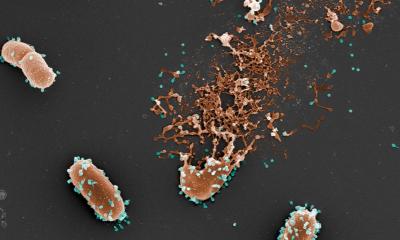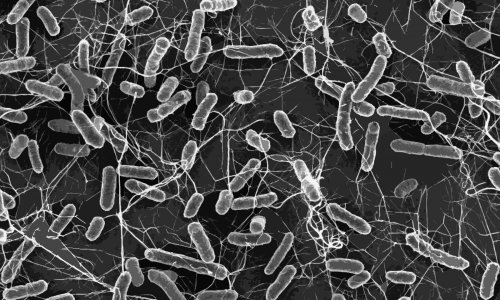Image source: Adobe Stock/Grycaj
News • Research on resistant bacteria
Emergence of 'superbugs' is not just because of antibiotics
For the first time, researchers have analysed the impact of antibiotic use on the rise of treatment-resistant bacteria over the last 20 years in the UK and Norway. They show that while the increase in drug use has amplified the spread of superbugs, it is not the only driver.
Researchers from the Wellcome Sanger Institute, the University of Oslo, the University of Cambridge, and collaborators, conducted a high-resolution genetic comparison of bacteria. They compared over 700 new blood samples with nearly 5,000 previously sequenced bacterial samples to answer questions about what factors influence the spread of antibiotic-resistant Escherichia coli (E. coli).
The study, published in the Lancet Microbe, shows that greater antibiotic use does drive an increase in treatment-resistant bacteria in some instances. However, researchers confirmed that this varies depending on the type of broad-spectrum antibiotic used. They also found that the success of antibiotic-resistance genes depends on the genetic makeup of the bacteria carrying them. Recognising all the main factors behind antibiotic resistance can help build a deeper knowledge of how these bacteria spread and what hinders them. This could then better inform public health interventions that use a complete view of the environment to help stop the spread of treatment-resistant infections.
Recommended article

Article • Bacterial defense mechanism
Antibiotic resistance: a global threat to healthcare
Antimicrobial resistance (AMR) is becoming more prevalent around the world, constituting a serious threat to public health. When bacteria acquire resistance against antibiotics, common medical procedures – for example, in surgery – become impossible due to the high infection risk. Keep reading to find out about AMR research, development of new antibiotics and antibiotic alternatives.
The bacterium, E. coli is a common cause of bloodstream infections worldwide.1 The type of E. coli responsible for these infections is commonly found in the gut, where it does not cause harm. However, if it gets into the bloodstream due to a weakened immune system it can cause severe and life threatening infections. As an added challenge for healthcare providers, antibiotic resistance, in particular multi-drug resistance (MDR), has become a frequent feature of such infections. In the UK, over 40% of E. coli bloodstream infections are resistant to a key antibiotic used in the treatment of serious infections in hospital.2 Rates of antibiotic resistance in E. coli vary globally. For example, the rate of resistance to a different antibiotic, one commonly used to treat urinary tract infections caused by E. coli, ranged from 8.4% to 92.9% depending on the country.3
Antibiotic resistance has been a topic of research for decades, and the surveillance data from previous studies have consistently shown an association between antibiotic use and an increased frequency of MDR in bacteria worldwide, including in the UK. Previous studies have suggested a stable coexistence of resistant and non-resistant E. coli strains and in some cases, the non-resistant bacteria are more successful. However, previously it was not possible to assess the role of the genetic drivers of this due to the lack of unbiased large-scale longitudinal data sets.
While it has long been accepted that the overuse of antibiotics plays a role in the rise and spread of superbugs, our study highlights that the level of drug resistance in widespread E. coli strains can vary substantially
Jukka Corander
This new study, from the Wellcome Sanger Institute, the University of Oslo, and collaborators, is the first time it has been possible to directly compare the success of the different strains of E. coli between two countries — Norway and the UK — and explain differences based on country-wide antibiotic usage levels.
By analysing data that spanned almost 20 years, they found that the use of antibiotics was linked to increased resistance in some instances, depending on the type of antibiotic. One class of antibiotics, non-penicillin beta-lactams, were used three to five times more on average per person in the UK compared to Norway. This has led to a higher incidence of infections by a certain multi-drug resistant E. coli strain. However, the UK also uses the antibiotic trimethoprim more often, but analysis did not uncover higher levels of resistance in the UK when comparing the common E. coli strains found in both countries.
The study found that the survival of MDR bacteria depended on what strains of E. coli were in the surrounding environment. Due to this and other selective pressures in an area, researchers concluded that it is not possible to assume that the widespread use of one type of antibiotic will have the same effect on antibiotic-resistant bacteria spread in different countries.
The scientists stress that their results warrant sustained research efforts to identify what else drives the spread of E. coli and other clinically important bacteria across a range of ecological settings. Further research is needed to fully understand the combined effect of antibiotics, travel, food production systems and other factors shaping the levels of drug resistance in a country. Understanding more about the strains that can outcompete antibiotic-resistant E. coli can lead to new ways to help stop the spread. For example, attempts that increase the amount of non-resistant, non-harmful bacteria in an area.
Dr Anna Pöntinen, co-first author from the University of Oslo, Norway and visiting scientist at the Wellcome Sanger Institute, said: “Our large-scale study allowed us to start to answer some of the long-standing questions about what causally drives multidrug-resistant bacteria in a population. This research was only possible due to the national systematic surveillance of bacterial pathogens that occurred in the UK and Norway. Without such systems in place, scientists would be considerably more limited in terms of what can be learnt using the power of genomics.”
Professor Julian Parkhill, co-author from the University of Cambridge, said: “Our study suggests that antibiotics are modulating factors in the success of antibiotic-resistant E. coli, instead of the only cause. Our research traced the impact of several different broad-spectrum antibiotics and shows that the influence of these varies by country and area. Overall, our comprehensive genetic analysis shows that it is not always possible to predict how the use of antibiotics will impact an area without knowing the genetic makeup of the bacterial strains in that environment.”
Professor Jukka Corander, senior author from the Wellcome Sanger Institute and the University of Oslo, Norway, said: “Treatment-resistant E. coli is a major global public health issue. While it has long been accepted that the overuse of antibiotics plays a role in the rise and spread of superbugs, our study highlights that the level of drug resistance in widespread E. coli strains can vary substantially. Antibiotic use will be one selective pressure, and our study shows that it is not the only factor that impacts the success of these bacteria. Continuing to use genomics to gain a detailed understanding of the underlying drivers of bacterial success is crucial if we are to control the spread of superbugs.”
References:
- Kern WV, Rieg S.: Burden of bacterial bloodstream infection – A brief update on epidemiology and significance of multidrug-resistant pathogens. Clin Microbiol Infect. 2020
- UK Health Security Agency. New data shows 148 severe antibiotic-resistant infections a day in 2021
- Wang. S, Zhao. S, Zhou, et al.: Antibiotic resistance spectrum of E. coli strains from different samples and age-grouped patients: a 10-year retrospective study. BMJ Open 2023
Source: Wellcome Sanger Institute
15.01.2024











